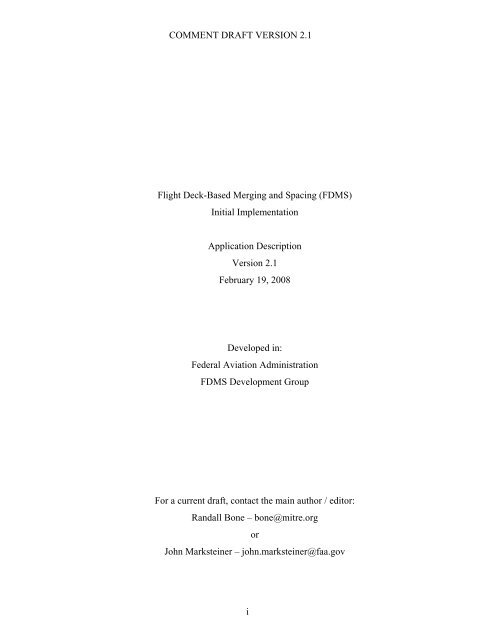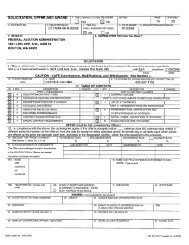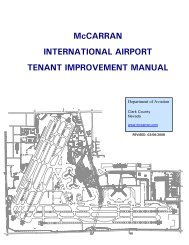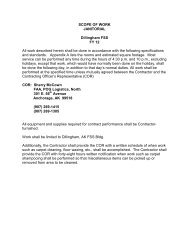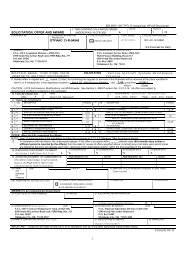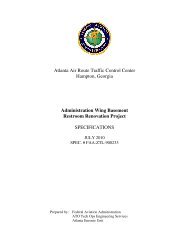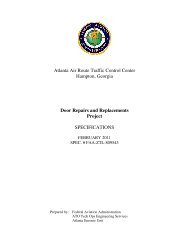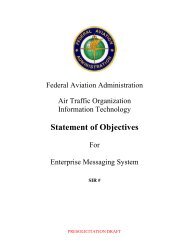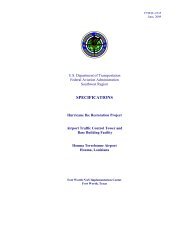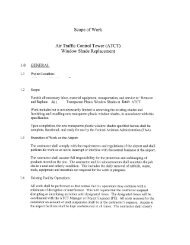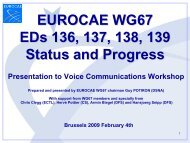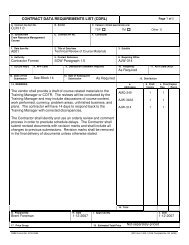Flight Deck-Based Merging and Spacing (FDMS) - FAACO - Federal ...
Flight Deck-Based Merging and Spacing (FDMS) - FAACO - Federal ...
Flight Deck-Based Merging and Spacing (FDMS) - FAACO - Federal ...
- No tags were found...
Create successful ePaper yourself
Turn your PDF publications into a flip-book with our unique Google optimized e-Paper software.
COMMENT DRAFT VERSION 2.1<strong>Flight</strong> <strong>Deck</strong>-<strong>Based</strong> <strong>Merging</strong> <strong>and</strong> <strong>Spacing</strong> (<strong>FDMS</strong>)Initial ImplementationApplication DescriptionVersion 2.1February 19, 2008Developed in:<strong>Federal</strong> Aviation Administration<strong>FDMS</strong> Development GroupFor a current draft, contact the main author / editor:R<strong>and</strong>all Bone – bone@mitre.orgorJohn Marksteiner – john.marksteiner@faa.govi
COMMENT DRAFT VERSION 2.1List of FiguresFigure 2-1. Sample chains of aircraft conducting <strong>FDMS</strong> with breaks in those chains. 2-2Figure 2-2. Sample <strong>Merging</strong> <strong>and</strong> <strong>Spacing</strong> Scenario between Aircraft A (Traffic To Follow) <strong>and</strong> B(trail aircraft). 2-3Figure 2-3. <strong>FDMS</strong> Transition Zone. 2-5Figure 2-4. Sample <strong>FDMS</strong> operation: Plan <strong>and</strong> Profile views. 2-8Figure 3-1. <strong>FDMS</strong> System States 3-3vi
COMMENT DRAFT VERSION 2.1Terms• ADS-B range – The range at which an aircraft can receive consistent ADS-B messagesfrom an aircraft (e.g., Traffic To Follow (TTF))• Lead aircraft – First aircraft in a chain of aircraft conducting <strong>Flight</strong> <strong>Deck</strong>-<strong>Based</strong> <strong>Merging</strong><strong>and</strong> <strong>Spacing</strong> (<strong>FDMS</strong>)• Comm<strong>and</strong>ed speed (CMD) – Speed computed by the <strong>FDMS</strong> system to achieve <strong>and</strong>maintain the spacing interval (SI) <strong>and</strong> displayed to the flight crew.• Trail aircraft – The aircraft performing <strong>FDMS</strong> relative to the TTF.• Traffic To Follow (TTF) – The reference aircraft for which the trail aircraft <strong>FDMS</strong> systemcomputes CMDs.• <strong>Spacing</strong> Interval (SI) – Target interval between a trail aircraft <strong>and</strong> TTF measured inseconds.• Field of View – The angular extent of the display that can be seen by either pilot with thepilot seated at either pilots station. (based on FAA, 2007)• Primary Field of View (FOV) – <strong>Based</strong> on the optimum vertical <strong>and</strong> horizontal visualfields from the design eye reference point that can be viewed with eye rotation only usingfoveal or central vision. (based on FAA, 2007)vii
COMMENT DRAFT VERSION 2.1AbbreviationsACARSADS-BAOCASASASSAPATCCDACDTICMDEFBFAAFAFFAS<strong>FDMS</strong>FMSIFRIMCLOAMCPMITMSDPFPMRNAVRNPSDFSISTARSTPTBDTODTTFUSVMCAircraft Communications Addressing <strong>and</strong> Reporting SystemAutomatic Dependent Surveillance-BroadcastAirline Operations CenterAirborne Separation Assistance SystemsAirborne Surveillance <strong>and</strong> Separation Assistance ProcessingAir Traffic ControlContinuous Descent ArrivalCockpit Display of Traffic InformationComm<strong>and</strong>ed SpeedElectronic <strong>Flight</strong> Bag<strong>Federal</strong> Aviation AdministrationFinal Approach FixFinal Approach Speed<strong>Flight</strong> <strong>Deck</strong>-<strong>Based</strong> <strong>Merging</strong> <strong>and</strong> <strong>Spacing</strong><strong>Flight</strong> Management SystemInstrument <strong>Flight</strong> RulesInstrument Meteorological ConditionsLetter of AgreementMode Control PanelMiles-In-TrailMCP <strong>Spacing</strong> DisplayPilot FlyingPilot MonitoringArea NavigationRequired Navigation PerformanceLouisville International Airport - St<strong>and</strong>iford Field<strong>Spacing</strong> IntervalSt<strong>and</strong>ard Terminal Arrival RouteSurveillance <strong>and</strong> Transmit ProcessingTo Be DeterminedTop of DescentTraffic-To-FollowUnited StatesVisual Meteorological Conditionsix
COMMENT DRAFT VERSION 2.1137138139140141142143144145146147148149150Zeghal, <strong>and</strong> Deransy, 2001; Aligne, Grimaud, Hoffman, Rognin, <strong>and</strong> Zeghal, 2003; Hebraud,Hoffman, Pene, Rognin, Sheehan, <strong>and</strong> Zeghal, 2004; Battiste, et al., 2005; Mogford <strong>and</strong>Kopardekar, 2004; Barmore, Abbott, Krishnamurthy, 2004; Lohr, Oseguera-Lohr, Abbott,<strong>and</strong> Capron, 2003; Krishnamurthy, Barmore, Bussink, Wietz, <strong>and</strong> Dahlene, 2005; Barmore,Abbott, <strong>and</strong> Capron, 2005; Bone, Helleberg, <strong>and</strong> Domino, 2003; Bone, Olmos, <strong>and</strong> Mundra,2001).The package carrier UPS is actively supporting the research on the application <strong>and</strong> expects toachieve significant operational benefits through early implementations of <strong>FDMS</strong>. AviationCommunication & Surveillance Systems (ACSS) has built <strong>and</strong> certified flight deck avionicscapable of conducting <strong>FDMS</strong> <strong>and</strong> other ADS-B applications. UPS has implemented <strong>FDMS</strong>during its west coast arrival bank operation. Aircraft in this bank arrive at UPS’ main sortinghub at the Louisville International Airport - St<strong>and</strong>iford Field (SDF). The UPSimplementation includes operations during CDAs.1-3
COMMENT DRAFT VERSION 1.51511521531541551561571581591601611621631641651661671681691701711721731741751761771781791801811821831841851862 Operational Concept, Roles, <strong>and</strong> Procedures2.1 Concept Description<strong>FDMS</strong> introduces a new method for flight crews, ATC, <strong>and</strong> AOCs to achieve a desired spacingbetween paired aircraft from the en route phase of flight down to approximately the FinalApproach Fix (FAF) in a manner consistent with today’s IFR procedures <strong>and</strong> criteria. It is bestcategorized as an Airborne Separation Assistance Systems (ASAS) <strong>Spacing</strong> category application(rather than a Situational Awareness, Separation, or Self-Separation application). <strong>Spacing</strong>applications have been defined as those where the flight crew is assigned a spacing task in relationto a TTF <strong>and</strong> there is no change in ATC separation responsibilities (<strong>Federal</strong> AviationAdministration (FAA) / EUROCONTROL Cooperative Research <strong>and</strong> Development, 2001).To conduct <strong>FDMS</strong>, a defined path must exist for participating aircraft. That includes one en routewaypoint <strong>and</strong> a structured terminal arrival procedure that joins an approach procedure. The arrivalprocedure can be a routing via airways or a STAR. The arrival may employ CDA procedures.CDAs are arrival procedures specifically designed to keep an aircraft at idle or near idle powerduring the entire arrival until approximately the FAF. CDAs may or may not utilize areanavigation (RNAV) / Required Navigation Performance (RNP) procedures. CDAs result in time<strong>and</strong> fuel savings as well as noise <strong>and</strong> emissions reductions. The CDA eliminates step-downaltitudes <strong>and</strong> the associated power increases. It is critical for the success of CDAs that there is littleor no vectoring during the procedure to maintain the arrival stream. To accomplish this, it requiresaircraft to be spaced <strong>and</strong> sequenced prior to descent as well as throughout the arrival.<strong>FDMS</strong> will start in the en route environment. For <strong>FDMS</strong> to begin, a set-up phase is conducted bythe AOC 1 . The AOC sets up a desired arrival sequence for the aircraft <strong>and</strong> approximates thedesired target spacing for the <strong>FDMS</strong> flights by up linking speed for the flight crew to fly. TheAOC then selects an aircraft pair for <strong>FDMS</strong>.After the trail aircraft reaches the <strong>FDMS</strong> transition zone, the AOC provides the flight crew anadvisory including information for the initiation of <strong>FDMS</strong>. At this point, the flight crew enters theinformation to initialize the <strong>FDMS</strong> system. <strong>FDMS</strong> can begin between the paired aircraft once theTTF is within range of the trail aircraft ADS-B receiver (termed ADS-B range). Pairs of <strong>FDMS</strong>aircraft can be formed into linked chains by allowing a trailing aircraft in one pair to be a TTF forits following aircraft, providing all aircraft in the chain are appropriately equipped. There can bebreaks in the chains of aircraft conducting <strong>FDMS</strong> (see Figure 2-1). <strong>Flight</strong> crews followcomm<strong>and</strong>ed speeds (CMDs) from <strong>FDMS</strong> to achieve the spacing interval (SI). The SI is achievedexclusively through speed changes. Vectoring or heading changes as well as altitude changes as ameans to achieve the SI are not part of <strong>FDMS</strong>. Throughout <strong>FDMS</strong>, it is expected that the trailaircraft will be temporally behind the TTF.1 There may be other methods for conducting this set-up phase. However, in the initial implementation, theAOC is expected to conduct this task.2-1
COMMENT DRAFT VERSION 2.1187188189190191192193194195196197198199200201202203204205206207208209210211212213TrailLead &Traffic tofollowLead &Traffic to Traffic to Traffic toTraffic toTraffic tofollow follow followfollowfollow Trail Trail Trail TrailTrail TrailLead &Traffic tofollowFigure 2-1. Sample chains of aircraft conducting <strong>FDMS</strong> with breaks in those chains.<strong>FDMS</strong> allows for more active flight crew participation in achieving the desired SI of an AOC <strong>and</strong>ATC. The flight crew follows the CMDs while the separation responsibility between aircraftremains with ATC. ATC will have knowledge of <strong>FDMS</strong> operations <strong>and</strong> will continue to monitor<strong>and</strong> be responsible for separation for all aircraft. The SI will be derived daily based on winds. TheSI will be derived to not violate ATC spacing or separation requirements in FAA Order 7110.65<strong>and</strong> will conform with Letters of Agreement (LOAs) <strong>and</strong> other airport or runway constraints. TheCMDs are calculated to achieve the SI. However, conditions may exist such that the trail aircraftis unable to fly a slow enough speed to maintain the SI. If that were the case, ATC will interveneif the spacing between the aircraft becomes an issue.<strong>FDMS</strong> is also designed such that SI, at any point, should match or exceed the distance needed bythe controller prior to h<strong>and</strong>off to a down stream sector as well as that needed in the terminal area<strong>and</strong> upon l<strong>and</strong>ing. ATC is expected to monitor <strong>and</strong> foster the operation while maintaining positivecontrol. ATC will attempt to prevent non-participating aircraft from interfering with <strong>FDMS</strong> <strong>and</strong>will attempt to avoid instructions contradictory to <strong>FDMS</strong>, unless necessary. If ATC requiredspacing between paired aircraft is different from that of <strong>FDMS</strong> or if ATC decides <strong>FDMS</strong> shouldbe discontinued, ATC will intervene to achieve their desired spacing interval. ATC will have theability to coordinate with the AOC daily. ATC may request a larger SI in order to meet the needsof the particular environmental conditions. ATC will inform the AOC if the requested SI violatesany of its spacing or separation requirements.<strong>FDMS</strong> continues for the aircraft pair until the trail aircraft is approximately at the FAF. At thispoint, active spacing by the trail aircraft stops <strong>and</strong> the flight crew configures normally <strong>and</strong> slowsto their Final Approach Speed (FAS).The following sections will review <strong>FDMS</strong> in detail. Figure 2-2 represents a sample overview ofthe application.2-2
COMMENT DRAFT VERSION 1.5DepartureTerminalTop ofclimbEn route Terminal L<strong>and</strong>ingMerge FixTop ofFinaldescent,ApproachCDAFix (FAF)entryBABAirline <strong>Based</strong> En-routeSequencing <strong>and</strong><strong>Spacing</strong> (ABESS)A A ABBArrival procedureApproachBABA<strong>Flight</strong> deck-based M&S (<strong>FDMS</strong>)MergeRemain behindBSet-UpConduct TerminationFigure 2-2. Sample <strong>Merging</strong> <strong>and</strong> <strong>Spacing</strong> Scenario between Aircraft A (Traffic To Follow) <strong>and</strong> B (trail aircraft).2-3
COMMENT DRAFT VERSION 1.52142152162172182192202212222232242252262272282292302312322332342352362372382392402412422432442.1.1 Set-up / TransitionFor <strong>FDMS</strong> to be successful, aircraft need to be sequenced <strong>and</strong> spaced during the en route phase offlight so that they can transition to <strong>FDMS</strong> in an appropriate configuration. The sequencing <strong>and</strong>spacing during the en route phase needs to be performed by someone that has a global picture ofthe aircraft <strong>and</strong> access to flight plans, such as an AOC or ATC. For example, the airline AOC canprovide speed comm<strong>and</strong>s to the aircraft in the en route phase to achieve the desired thesequencing <strong>and</strong> spacing prior to the transition to <strong>FDMS</strong>. The AOC will achieve this via a conceptcalled ABESS (FAA, 2007). Another concept that performs the same function could also be used.The set-up to <strong>FDMS</strong> can occur via ATC or via concepts under development, such as ABESS(FAA, 2007). It is believed that a more strategic set-up like that of ABESS increases theopportunities for the conduct of <strong>FDMS</strong> <strong>and</strong> reduces the amount of ATC vectoring withoutABESS-like set-up. While the sequencing <strong>and</strong> spacing of aircraft may be conducted by ATC, thesending of a <strong>FDMS</strong> initiation data will come from the AOC. This section will describe theABESS set-up for <strong>FDMS</strong>.The set-up / transition phase starts after a set of aircraft that have departed from multiple airports,have reached their top of climb, <strong>and</strong> are scheduled <strong>and</strong> flight planned to arrive over a commonmerge fix. The merge fix will be an en route fix prior to the top of descent in the aircraft’s flightplan. Prior to <strong>FDMS</strong> conduct, the AOC sets an arrival sequence for <strong>FDMS</strong> flights. The AOC maythen provide speed advisories to space flights for optimized arrival flows <strong>and</strong> facilitate transitioninto <strong>FDMS</strong>. The AOC will also coordinate with ATC, on a daily basis, that <strong>FDMS</strong> will be ineffect. They will provide information on which arriving aircraft are capable of performing <strong>FDMS</strong><strong>and</strong> the planned SI between paired aircraft.<strong>FDMS</strong> conduct can begin after the <strong>FDMS</strong> transition zone has been reached by the trail aircraft.The selection of the <strong>FDMS</strong> transition zone depends on operational characteristics such as airspace<strong>and</strong> traffic. It is desirable to set the transition zone at a point where aircraft pairs may still havespacing issues to resolve with <strong>FDMS</strong> but before ATC feels the need to intervene to achieve themerge. To reduce the likelihood of ATC intervention, the transition zone may be at the entrance tothe sector prior to the merge sector, as depicted in Figure 2-3. At this point, aircraft should bereasonably spaced <strong>and</strong> appear to be either resolving any spacing issues or have sufficient distanceto resolve the spacing issue via <strong>FDMS</strong> without ATC intervention.2-4
COMMENT DRAFT VERSION 2.1Pre-<strong>FDMS</strong><strong>FDMS</strong><strong>FDMS</strong> Transition ZoneSectors prior to <strong>FDMS</strong>MergeFixMergeSector245246247248249250251252253254255256257258259260261262263264265Sector Prior to Merge SectorFigure 2-3. <strong>FDMS</strong> Transition Zone.The AOC decides whether to initiate <strong>FDMS</strong> for a pair of aircraft if all of the following conditionsare met:• The trail aircraft reached the <strong>FDMS</strong> transition zone.• The trail aircraft is <strong>FDMS</strong> equipped with no known equipment issues.• The trail aircraft flight crew is qualified for <strong>FDMS</strong>.• The TTF <strong>and</strong> trail aircraft are spaced such that the SI is feasible.• The trail aircraft does not become an aircraft that causes instability in a chain of <strong>FDMS</strong>aircraft 2 .If a decision is made to conduct <strong>FDMS</strong> between the paired aircraft, an initiation message will beuplinked via data link (e.g., Aircraft Communications Addressing <strong>and</strong> Reporting System(ACARS)). The message includes the flight identification of the TTF, the common mergewaypoint, <strong>and</strong> the SI. An altitude restriction may also be sent for certain CDA operations. Theflight crew is not required to detect errors in this message. However, if the flight crew isuncomfortable with or questions any information in the message, the flight crew can ask the AOCfor a new initiation message. If after the second uplink, the flight crew still believes the message iserroneous, they will choose not to transition to <strong>FDMS</strong>. The flight crew can also choose to notconduct <strong>FDMS</strong> based on other operational requirements. If the <strong>FDMS</strong> transition is not chosen, theflight crew will not contact the AOC <strong>and</strong> continues non-<strong>FDMS</strong> operations.2 To prevent potential instabilities in a chain of <strong>FDMS</strong> aircraft, the number of pairs of aircraft may initially belimited to three or four.2-5
COMMENT DRAFT VERSION 2.1266267268269270271272273274275276277278279280281282283284285286287288289290291292293294295296297298299300301302303If the initiation message is not rejected, the flight crew replies with an acknowledgement whichimplies the flight crew got the message <strong>and</strong> plans to conduct <strong>FDMS</strong>. The <strong>FDMS</strong> transition iscomplete once the flight crew has entered the initiation message elements into the <strong>FDMS</strong> system<strong>and</strong> the AOC receives the acknowledgement message, regardless of whether <strong>FDMS</strong> is actuallyinitiated. Entry of the information <strong>and</strong> flight crew activation arms the <strong>FDMS</strong> system. The armedstate of the system is annunciated to the flight crew.During the time the <strong>FDMS</strong> system is armed but not yet engaged, the flight crew will follow thelast speed comm<strong>and</strong> provided by the AOC. No new speed comm<strong>and</strong>s will be sent by the AOCduring this period. The transition to the conduct phase occurs once the TTF enters ADS-B range,the TTF meets the necessary (TBD) performance requirements, both aircraft meet the same pathcriteria, <strong>and</strong> no system failures exist. At this point, the <strong>FDMS</strong> system engages.2.1.2 Conduct through TerminationAfter the ABESS strategic set-up, flight deck systems are now used to fine-tune the arrival <strong>and</strong>l<strong>and</strong>ing interval. CMDs are provided by the <strong>FDMS</strong> system that is targeting the SI. The flight crewis notified of the arrival of a new CMD through a visual annunciation beyond simply the changingof the value. The annunciation of the new CMD will be extinguished after a period that is deemedappropriate to capture flight crew attention. While the annunciation of the new CMD will beextinguished, the CMD itself will remain continually displayed for the flight crew.The presentation of the CMD will be designed such that it is not necessary for the flight crew tocontinually monitor the TTF position on a display such as a multi-function display hosting aCDTI. For example, if the CMD were available at all times regardless of whether the TTF werevisible, the flight crew may select other functions or chose other display ranges for tasks such asweather monitoring. However, should a graphic traffic display be present, the flight crew couldmonitor the TTF position, as desired. The <strong>FDMS</strong> system could also alert the flight crew that aCMD was received <strong>and</strong> no speed input has been made for an extended (TBD) period of time;however, this is not a minimum requirement.The <strong>FDMS</strong> system may provide CMDs outside the aircraft speed envelop based on the aircraftscurrent configuration 3 . It is then up to the flight crew to determine whether to fly the CMD,configure the aircraft so that the CMD can be flown, or reject the CMD as is done today withATC speed instructions. The CMDs are suggested speeds to fly to achieve the SI <strong>and</strong> are notm<strong>and</strong>atory speeds to fly.With the presentation of each CMD, the flight crew ensures that the CMD is feasible in thecurrent configuration / conditions. Current procedures for notifying ATC of speed changes willcontinue to be in effect. This application does not change any existing requirement or introducenew speed change notification procedures. When appropriate, the flight crew implements thespeed through entry in the Mode Control Panel (MCP) or FMS. The flight crew follows theCMDs from the en route environment <strong>and</strong> allows ownship to gradually close on the SI as it flies tothe merge fix then joins an arrival procedure. The arrival procedure will be defined in the3 It is not a minimum requirement of the equipment to prohibit the display of CMDs outside the aircrafts currentflight envelop. However, such a feature would be desirable.2-6
COMMENT DRAFT VERSION 2.1304305306307308309310311312313314315316317318319320321322323324325326327328329330331332333334335336337338necessary aircraft navigation databases <strong>and</strong> will include expected speeds at waypoints for aircraftnot conducting <strong>FDMS</strong>. After the merge fix, the flight crew will fly CMDs to maintain the SI.The CMDs are provided until the trail aircraft reaches approximately the FAF. At this point, theCMDs are no longer displayed. The flight crew discontinues following CMDs <strong>and</strong> slows to theFAS <strong>and</strong> configures the aircraft for a normal l<strong>and</strong>ing using conventional means. It is possible thata design could choose to provide CMDs to the FAS <strong>and</strong> provide a final CMD at approximatelythe FAF that matches the planned FAS.<strong>FDMS</strong> terminates if ATC inserts an aircraft between an aircraft conducting <strong>FDMS</strong> <strong>and</strong> its TTF.At this point, ATC would terminate <strong>FDMS</strong> by providing aircraft conducting <strong>FDMS</strong> with a speedor vector instruction.2.1.2.1 CDA Specific ProceduresAn initial implementation of <strong>FDMS</strong> will be for UPS operations through a CDA. This section willdescribe that specific implementation <strong>and</strong> may not be applicable to all <strong>FDMS</strong> operations duringCDAs.As mentioned previously a continuous path from en route merge points to the runway threshold isrequired for <strong>FDMS</strong>. This could be accomplished through either a STAR or CDA that is connectedto an approach procedure. A CDA is conducted differently than a STAR so the following willdescribe <strong>FDMS</strong> operations through a CDA.The initiation of the CDA will be at an AOC determined altitude crossing restriction for allaircraft. The crossing restriction will be determined on a nightly basis based on the aircraft withthe lowest altitude <strong>and</strong> the winds for that day. The vertical profile from the crossing restriction willbe a fixed path angle for all aircraft. That angle will change based on the winds for each night. Thecrossing restriction will be sent by the AOC in the <strong>FDMS</strong> initiation message. Each aircraft isgiven the AOC altitude crossing restriction at the same point <strong>and</strong> at the altitude of the lowestaircraft in the string. The crossing restriction is based on a chart residing with the AOC. Therestriction would be given approximately 100 miles prior to TOD. This AOC restriction will be achange to the TOD point for the CDA <strong>and</strong> will need to be requested of ATC by the flight crew forATC approval.At the crossing restriction, the flight crew reduces power to a level sufficient for the CDA arrivaldescent path. The aircraft are on a common lateral <strong>and</strong> vertical path throughout, as defined by theCDA. It is expected that the aircraft will deviate from the CDA waypoint speeds to follow CMDs,as needed. The flight crew continues following the CMDs as they traverse the CDA. The CDAwill deliver aircraft onto final outside the FAF on the localizer for the approach procedure. Fromthis point on, <strong>FDMS</strong> operations remains the same as described in the previous section. Figure 2-4shows a sample diagram of this operation.2-7
COMMENT DRAFT VERSION 1.5<strong>FDMS</strong>InitiationMergeWaypointAltitudeRestrictionTRACONEntryProfileViewPlanViewContinuous Descent Arrival (CDA)Approach& L<strong>and</strong>ingEn routeTerminalFigure 2-4. Sample <strong>FDMS</strong> operation: Plan <strong>and</strong> Profile views.2-8
COMMENT DRAFT VERSION 1.53393403413423433443453463473483493503513523533543553563573583593603613623633643653663673683693703713723733743753762.1.3 Non-normal <strong>and</strong> Off Nominal ConditionsIf ATC needs to provide a speed or heading instruction to either aircraft at any time during theconduct of <strong>FDMS</strong>, it will do so. ATC-initiated speed or heading instructions to either the trail orTTF affects <strong>FDMS</strong>.If the trail aircraft takes a heading off of their route or receives a vector from ATC, the flight crewflies that heading <strong>and</strong> deactivates the <strong>FDMS</strong> function at which point CMDs are no longerprovided <strong>and</strong> the system is disengaged. If the flight crew were to not deactivate, the <strong>FDMS</strong> systemwill detect the deviation <strong>and</strong> will discontinue sending CMDs. <strong>FDMS</strong> stops at that point <strong>and</strong> theflight crew continues to fly the last CMD. If the trail aircraft is given a speed instruction fromATC, the flight crew flies that speed <strong>and</strong> deactivates the <strong>FDMS</strong> function at which point CMDs areno longer provided. After deactivating, flight crews would be expected to fly speeds issued byATC or required by procedure. If the aircraft is able to resume its speed or rejoin the routing ofother <strong>FDMS</strong> aircraft, <strong>FDMS</strong> could be activated through flight crew action. Activation could onlyoccur on the same TTF with the same SI. ATC could allow such re-activation through instructionssuch as “resume normal speed” or “speed your discretion.”If the TTF takes a heading off of its route, the <strong>FDMS</strong> system will detect this deviation, disengage,<strong>and</strong> discontinue the display of CMDs. The annunciation of disengaging <strong>and</strong> the discontinueddisplay of CMDs will be the indication to the trail aircraft flight crew of the TTF deviation <strong>and</strong>termination of <strong>FDMS</strong>. The flight crew is not expected to detect this event on a display such as aCDTI. At this point, the flight crew would stop <strong>FDMS</strong>. If the TTF rejoins the routing of other<strong>FDMS</strong> aircraft, <strong>FDMS</strong> could be re-activated through flight crew action. Re-engagement couldonly occur on the same TTF with the same SI. If ATC had provided a speed instruction, it couldallow such re- activation through instructions such as “resume normal speed” or “speed yourdiscretion.” If ATC had not provided a speed instruction, the flight crew could re-activate <strong>and</strong> thenannounce the start of <strong>FDMS</strong>.ATC altitude instructions do not terminate <strong>FDMS</strong> operations, nor does an ATC speed instructionto the TTF.Disarming occurs once <strong>FDMS</strong> requirements are not met (see section 3.1.2.2). When the <strong>FDMS</strong>requirements are not met, the system transitions from an engaged state to a disarmed state. Reengagementis allowed throughout all operations. To re-engage, the flight crew will have tomanually re-enter the <strong>FDMS</strong> initiation message information 4 .A re-engagement during the merge environment would occur when <strong>FDMS</strong> requirements are onceagain satisfied. A re-engagement after a vector in the remain behind / post-merge environmentcould initiate a new merge operation if the flight crew was cleared direct to the next commonmerge point or could resume as a remain behind operation should the flight crew be cleared toreturn to path.If ATC inserted an aircraft between an aircraft conducting <strong>FDMS</strong> <strong>and</strong> its TTF, ATC wouldterminate <strong>FDMS</strong> by providing aircraft conducting <strong>FDMS</strong> with a speed or vector instruction.4 It may be desirable for the <strong>FDMS</strong> system to store this information to prevent the flight crew from having to reenterit.2-9
COMMENT DRAFT VERSION 2.13773783793803813823833843853863873883893903913923933943953963973983994004014024034044054064074084094104114124132.1.4 Aircraft Not Participating in <strong>FDMS</strong> / Mixed EquipageIt is expected that the unequipped aircraft will be able to operate in the same airspace <strong>and</strong> arrive atairports while other aircraft are conducting <strong>FDMS</strong>. In the initial UPS implementation, <strong>FDMS</strong>aircraft will be in a stream of aircraft that are arriving for a CDA. In the stream to the CDA will be(1) aircraft that are not capable of <strong>FDMS</strong>, (2) aircraft that are capable of <strong>FDMS</strong> but not able to doso due to an excessive spacing gap, <strong>and</strong> (3) aircraft that are <strong>FDMS</strong> capable <strong>and</strong> conducting<strong>FDMS</strong>. Aircraft that were conducting <strong>FDMS</strong> but had to terminate can either remain in the <strong>FDMS</strong>flow under ATC speed control or exit the <strong>FDMS</strong> flow <strong>and</strong> follow a different route. Additionally,aircraft that are required to go-around will be sequencing into the arrivals as required. Someimplementations may allow for leaving a gap every [TBD] aircraft or the addition of a spacingbuffer between paired aircraft that can later be adjusted to allow for the insertion of anotheraircraft. Analysis needs to be done to determine the need for these contingency slots <strong>and</strong> theirfrequency.2.2 Procedures <strong>and</strong> Responsibilities2.2.1 Ground2.2.1.1 Air Traffic ControlWhen <strong>FDMS</strong> is being conducted, ATC will have knowledge of <strong>FDMS</strong> operations <strong>and</strong> willcontinue to monitor <strong>and</strong> be responsible for separation for all aircraft. The AOC will inform ATCof <strong>FDMS</strong> capable aircraft. The most practical long-term method of identifying capable aircraft tocontrollers is currently under evaluation. Such information could be included in the aircraft flightplan or could be manually entered locally in the flight data block. When possible, the aircraft’sequipage should be conveniently available “on the glass” whenever that information is required.<strong>Flight</strong> crews will notify ATC of <strong>FDMS</strong> conduct <strong>and</strong> termination. While ATC will know that<strong>FDMS</strong> is being conducted via flight crew notification, it is not expected that ATC will need toknow or receive from the flight crew specific details such as which aircraft are paired. ATC is alsonot expected to need to know which aircraft are acting as lead aircraft. ATC will not give specificclearances for <strong>FDMS</strong> but will give normal clearances required for the arrival <strong>and</strong> approachoperations. ATC will acknowledge flight crew notification of <strong>FDMS</strong> operations.ATC responsibilities do not change when <strong>FDMS</strong> is being conducted. They continue to monitor<strong>and</strong> be responsible for separation for all aircraft. The objective of <strong>FDMS</strong> is to achieve a desired SIbetween successive arriving aircraft. The desired interval at any point should match or exceed thedistance needed by the controller prior to h<strong>and</strong>off to a down stream sector as well as that neededin the terminal area <strong>and</strong> upon l<strong>and</strong>ing. If the ATC required spacing is different from that of<strong>FDMS</strong> 5 , ATC will intervene as they do today to achieve their desired spacing. ATC will alsointervene if there may be a spacing or separation issue with a non-participating aircraft. Asmentioned previously, instructions from ATC can terminate <strong>FDMS</strong> for the affected aircraft. Theflight crew may re-engage <strong>FDMS</strong> if all parameters that enabled the <strong>FDMS</strong> operation still exist. If5 This condition could exist if a thunderstorm develops in the terminal area <strong>and</strong> the en route controller is told toincrease spacing between aircraft.2-10
COMMENT DRAFT VERSION 2.1414415416417418419420421422423424425426427428429430431432433434435436437438439440441442443444445446447448449450451at any time ATC decides <strong>FDMS</strong> should be discontinued, there is a return to current operationswithout <strong>FDMS</strong> for the affected aircraft. In order to avoid potential conflicts between AOC desiredspacing <strong>and</strong> that of ATC, ATC will have the ability on a daily basis to coordinate with the AOCprior to <strong>FDMS</strong> operations initiating <strong>and</strong> to request a SI for the set of aircraft larger than thatrequested by the AOC in order to meet needs of the particular environmental conditions. ATC willalso inform the AOC if the requested SI is in conflict with its spacing <strong>and</strong> / or separationrequirements.En route <strong>and</strong> terminal controllers will monitor the operation with positive control, but allow theoperation to be conducted without input to the extent that separation or spacing does not become afactor. As they do normally, they will receive <strong>and</strong>, if appropriate, clear the flight crews for anyheading or speed requests. ATC will attempt to prevent non-participating aircraft from interferingwith <strong>FDMS</strong> operations to the extent possible. For example, if ATC desires to resolve a situationbetween two aircraft <strong>and</strong> doesn’t have a preference for which aircraft path is modified, thecontroller would be expected to modify the path of the non-<strong>FDMS</strong> aircraft. ATC is also expectedto avoid instructions contradictory to <strong>FDMS</strong> operations, unless necessary. For example, ATCwould not be expected to offer routing that conflicts with the <strong>FDMS</strong> routing, e.g., ATC should notoffer direct routing to shorten the defined arrival procedure. In order for ATC to fulfill thesedesired outcomes, it will need to have an underst<strong>and</strong>ing of the goals <strong>and</strong> desires for <strong>FDMS</strong>.UPS plans to notify the associated ATC facilities of the fact that <strong>FDMS</strong> will be in effect as well aswhich aircraft <strong>and</strong> flight crew are capable.2.2.1.2 Airline Operations CenterThe AOC will file the appropriate flight plans that include any necessary information on <strong>FDMS</strong>equipage. The AOC will coordinate with the ATC TMU facilities that <strong>FDMS</strong> operations will bein effect, the aircraft that are capable of performing <strong>FDMS</strong>, <strong>and</strong> the planned SI between aircraftpairs 6 . The AOC will use a ground-based tool to set the sequence of <strong>FDMS</strong> aircraft <strong>and</strong> todetermine which aircraft pairs transition to <strong>FDMS</strong>. The AOC must send an initiation message tothe flight crew with the appropriate information to transition to <strong>FDMS</strong>. If performing CDA’s, theAOC also uplinks an altitude crossing restriction. The initiation message will be sent via data link(e.g., ACARS). If the flight crew requests clarification, the AOC will need to send anotherinitiation message. After sending the second initiation message or if no second transmissionoccurs, the AOC tasks are complete.2.2.2 Airborne2.2.2.1 <strong>Flight</strong> <strong>Deck</strong><strong>Flight</strong> crews will interact with on-board systems to allow for the conduct <strong>FDMS</strong>. The flight crewresponsibilities are to fly the CMDs, when appropriate, <strong>and</strong> monitor for annunciated equipmentrelatedfailures. The flight crew is expected to follow the CMDs except when operationallimitations exist or when receiving counter instructions from ATC. The flight crew is required todiscontinue flying CMDs <strong>and</strong> to disengage the <strong>FDMS</strong> system upon receiving an ATC speed or6 Methods of informing ATC include LOAs <strong>and</strong> entry of information in the flight plan.2-11
COMMENT DRAFT VERSION 2.1452453454455456457458459460461462463464465466467468469470471472473474475476477478479480481482483484485486487488489490vector instruction. Should the CMDs be no longer provided, the flight crew is expected tocontinue to fly their current speed until flying a controller-issued or procedurally required speed.The flight crew is not responsible for monitoring a display such as a CDTI to detect spacing orseparation issues related to the TTF. The flight crew is required to notify ATC that they havebegun or terminated <strong>FDMS</strong> (see Phraseology section). The flight crew will not contact ATC torequest support for <strong>FDMS</strong> operations. ATC does not have the appropriate tools to assist in thesupport of <strong>FDMS</strong>. The flight crew will only contact ATC announcing the conduct or terminationof <strong>FDMS</strong>.The flight crew decides if the CMD can be safely implemented <strong>and</strong> then takes the appropriateaction to either fly or refuse the CMD. The <strong>FDMS</strong> system may provide CMDs outside the aircraftspeed envelope based on the current configuration. It is then up to the flight crew to determinewhether to fly the CMD, reject the CMD, or to configure the aircraft so that the CMD can beflown. This is not unlike operations today where ATC provides speed instructions <strong>and</strong> the crewmust decide if the speed is acceptable then accept or deny. Current procedures for notifying ATCof speed changes will continue to be in effect. This application does not change any existingrequirement or introduce new speed change notification procedures.The flight crew has the option to re-activate <strong>FDMS</strong> on the same TTF <strong>and</strong> SI if the requiredconditions exist.The flight crew may terminate or choose not to participate in <strong>FDMS</strong> at any time shouldoperational requirements or safety reasons prevent participation. Upon termination, the flight crewwill notify ATC <strong>and</strong> ATC will determine whether the aircraft remains in a <strong>FDMS</strong> stream. If at anytime the flight crew is not able to follow the CMD, the crew will maintain their present speed untilthey are able to fly the CMD or disengage the <strong>FDMS</strong> system.2.3 Proposed New PhraseologyNew phraseology will be used by the flight crew. When the flight crew starts <strong>FDMS</strong>, re-starts<strong>FDMS</strong>, or checks on to a new frequency they will provide a notification to ATC with thefollowing phraseology.• “[ATC facility], [Ownship call sign], [altitude], company spacing”After this notification, ATC is expected to acknowledge the notification with the following orsimilar phraseology.• “[Call sign], [ATC facility], Roger”If the flight crew has to terminate <strong>FDMS</strong> operations (at point other than normal termination pointaround the FAF), they will notify ATC with the following phraseology.• “[ATC facility], [Ownship call sign], terminating company spacing”After this notification, ATC is expected to acknowledge the notification with the following orsimilar phraseology.2-12
COMMENT DRAFT VERSION 2.1491492493494495496497498499500501502503504505506507508509510• “[Call sign], [ATC facility], Roger. [instructions as necessary]”If ATC has terminated <strong>FDMS</strong> via a vector to ownship (which then provokes flight crewmanual deactivation), the flight crew would not announce the termination since ATCinitiated the termination <strong>and</strong> assumes termination.“Company spacing” is used by the flight crew to indicate both that a spacing task isoccurring <strong>and</strong> that it is “company” specific <strong>and</strong> others can not request the operation. The callsign of the TTF <strong>and</strong> the SI are not used in the communication.2.4 Aircraft Separation / <strong>Spacing</strong> CriteriaThere are no changes in separation or spacing criteria. The SI will be derived daily based onwinds. The SI will be derived to not violate ATC spacing or separation requirements in FAAOrder 7110.65 <strong>and</strong> will conform with LOAs <strong>and</strong> other airport or runway constraints. The CMDsare calculated to achieve the SI. The SI will factor in a “comfort” buffer so that ATC hasconfidence that the spacing will remain outside their spacing or separation requirements.However, conditions may exist such that the trail aircraft is unable to fly a slow enough speed tomaintain the SI. If that were the case, ATC would be expected to intervene if the spacing betweenthe aircraft pair becomes an issue.2.5 Sample ScenariosTBD2-13
COMMENT DRAFT VERSION 2.15115125135145155165175185195205215225235245255265275285295305315325335345355365375385393 Requirements3.1 Display & Interface / Functional3.1.1 Ground3.1.1.1 ATCATC is not expected to need new functional capabilities to support <strong>FDMS</strong>. It is expected thatATC will be informed of the operation <strong>and</strong> a specific aircraft’s ability to perform <strong>FDMS</strong> throughinformation in flight plans <strong>and</strong> LOAs.3.1.1.2 AOCThe AOC will perform the following actions.(1) Determine aircraft <strong>FDMS</strong> equipage status <strong>and</strong> flight crew <strong>FDMS</strong> training status;(2) File a flight plan including any necessary information on <strong>FDMS</strong> equipage;(3) Determine aircraft sequence <strong>and</strong> pairing;(4) Determine the <strong>FDMS</strong> transition zone <strong>and</strong> aircraft position in relation to that zone;(5) Generate desired SI for paired aircraft;(6) Determine whether the SI is potentially feasible for the c<strong>and</strong>idate aircraft pair; <strong>and</strong>(7) Provide the <strong>FDMS</strong> initiation message to the trail aircraft;i. Note: The initiation message includes the flight identification of the TTF, thecommon merge point, <strong>and</strong> the SI.(8) Receive flight crew acknowledgement of <strong>FDMS</strong> initiation message.3.1.2 Airborne3.1.2.1 <strong>Flight</strong> crewThe flight crew will perform the following actions.(1) Select the TTF based on flight identification;(2) Input the merge waypoint 7 ;i. Note: The merge waypoint is the location where all participating <strong>FDMS</strong>aircraft converge prior to flying a common lateral path.(3) Input the SI;(4) Activate the <strong>FDMS</strong> function;(5) Determine the state of the <strong>FDMS</strong> system (i.e., armed, engaged, disarmed);7 The merge waypoint will be part of the flight plan in the FMS. The waypoint will be entered in the sameformat as that in the flight plan.3-1
COMMENT DRAFT VERSION 2.1540541542543544545546547548549550551552553554555556557558559560561562563564565566567568569570571572573(6) View the CMD;(7) Determine when a new CMD has arrived;ii. Note: The annunciation of the new CMD will need to be more than simply thechanging of the value of the CMD. The annunciation needs to be attentiongetting.iii. Note: The annunciation of the new CMD will be extinguished after a periodthat is deemed appropriate to capture flight crew attention. However, the CMDitself will remain visible at all times.(8) Monitor the <strong>FDMS</strong> system for failures; <strong>and</strong>(9) De-activate the <strong>FDMS</strong> function.It is expected that the main information elements necessary for the flight crew are the CMDs <strong>and</strong>annunciations of failure conditions. Speed comm<strong>and</strong>s <strong>and</strong> associated alerting should be in primaryfield of view of at least one pilot. It may be desirable for the flight crew to have a graphic displayof ownship <strong>and</strong> traffic for situation awareness. This information should be in the field of view.3.1.2.2 <strong>FDMS</strong> SystemThe ADS-B system on the trail aircraft flight deck will include the Airborne Surveillance <strong>and</strong>Separation Assistance Processing (ASSAP) including the <strong>FDMS</strong> system, <strong>and</strong> Surveillance <strong>and</strong>Transmit Processing (STP) systems (see RTCA, 2003 for further details on these systems). ACDTI is not a minimum requirement but it could be beneficial for the traffic awareness function.The flight crew is not required to detect anything on a display such as a CDTI <strong>and</strong> the requiredinformation elements do not include the graphic display of traffic. The <strong>FDMS</strong> application ismainly comprised of a speed algorithm. The TTF aircraft only needs to have the STP system <strong>and</strong>the flight crew of the TTF need not know it is acting as a TTF.The <strong>FDMS</strong> system will need to be able to receive the ADS-B messages from the TTF <strong>and</strong>determine whether the performance data is of suitable quality for acting as a <strong>FDMS</strong> TTF.The algorithm will generate CMDs that allow the flight crew to achieve <strong>and</strong> maintain the SI. Thequantization of those CMDs will be implementation specific. The system will only provide validCMDs. CMDs known to be invalid will not be provided to the flight crew. Additionally, upon anyfailure condition, the CMDs would not be provided <strong>and</strong> / or removed from the display. Theaircraft should reach the SI with the appropriate tolerances when the ownship crosses the mergefix <strong>and</strong> then maintain the SI while remaining in-trail. If the aircraft, doesn’t reach the target SI, thesystem will continue to attempt to achieve the SI for the remainder of the flight. Individual aircraft<strong>and</strong> a system wide stability are highly desirable. The algorithm should allow for safe, efficient,<strong>and</strong> stable flight operations.Although the system can provide CMDs outside the current aircraft envelope, a minimumrequirement for the system would be to have a static minimum <strong>and</strong> maximum possible CMDwithout knowledge of aircraft configuration changes. If configuration change information wereavailable, it would be desirable to have dynamic minimum <strong>and</strong> maximum CMDs. Another3-2
COMMENT DRAFT VERSION 2.1574575576577578579580581582583584585586587588589590minimum requirement is that the system not provide a speed greater than 250 knots below 10,000feet, where such a speed limit exists.The <strong>FDMS</strong> system can be in one of three states: disarmed, armed, or engaged. The states aredefined below.• Disarmed – System has incomplete <strong>FDMS</strong> initiation data <strong>and</strong> / or <strong>FDMS</strong> TTF requiredperformance data is of insufficient quality. <strong>Flight</strong> crew action is required for a transition toarmed.• Armed – Full <strong>FDMS</strong> initiation data set entered <strong>and</strong> in system. System is waiting toreceive <strong>FDMS</strong> TTF required performance data <strong>and</strong> determine <strong>FDMS</strong> qualification.• Engaged – System has all <strong>FDMS</strong> initiation data <strong>and</strong> <strong>FDMS</strong> TTF required performancedata. Ownship <strong>and</strong> the TTF meet the same path criteria. System is providing CMDs.The flight crew can activate or deactivate the system. Activate is the action taken to allow thesystem to transition from disarmed to armed while deactivation allows the system to return to adisarmed state.Each of the transitions between the states requires either flight crew or equipment action, asshown in Figure 3-1.(1) System has<strong>FDMS</strong> initiationdata AND(2) <strong>Flight</strong> crewactivates systemAND(3) No systeminternal failuresDisarmed(1) System does nothave <strong>FDMS</strong>initiation data OR(2) <strong>Flight</strong> crewdeactivatessystem OR(3) System internalfailures(1) Conditions for “Engaged” nolonger met OR(2) <strong>Flight</strong> crew deactivates systemArmed(1) Conditions for “Armed” met AND(2) <strong>FDMS</strong> TTF required ADS-B data is available<strong>and</strong> of sufficient quality AND(3) Ownship <strong>and</strong> TTF meet the same path criteriafor merging or to remain behind AND(4) Not internal system failuresEngaged591592593594595(No flight crew action required)Figure 3-1. <strong>FDMS</strong> System StatesThe engaged state is the only state that has the annunciation of CMDs. Other states will not haveany CMDs annunciated <strong>and</strong> will remove any previously annunciated CMDs. On disarming, the3-3
COMMENT DRAFT VERSION 2.1596597598599600601602603604605606607608609610611612613614615616617618619620621622623624625626627628system may retain in memory the set-up parameters (i.e., merge fix, SI, TTF) <strong>and</strong> may continuecueing TTF data. However, this is not a minimum system requirement. Additionally, it is notrequired but optional, <strong>and</strong> potentially desirable under certain conditions, to transition fromengaged to armed (instead of to disarmed), thereby allowing automatic re-engaging whenrequirements are again satisfied.The <strong>FDMS</strong> system could attempt to detect a grossly improper SI set by the flight crew. However,this is not a minimum requirement.The flight deck system will have a check to determine whether the TTF has exceeded the [TBD]criteria for being a TTF <strong>and</strong> will either not engage or disarm at that point. The flight deck systemwill have an ability to determine when the TTF has deviated from the designated path. Once thatdeviation is detected, the system will disarm <strong>and</strong> CMDs will no longer be provided.The system is expected to inform the flight crew to the following conditions.• Arrival of a new CMD• Annunciate current system state (i.e., disarmed, armed, <strong>and</strong> engaged)• Annunciate system failure states3.1.2.2.1 Acceptable Geometries• Trail aircraft must be temporally behind the TTF;• Aircraft pairs must have a common merge waypoint in their respective flight paths; <strong>and</strong>• Aircraft pairs must be on the same defined flight path / procedure when in-trail.3.1.2.2.2 Input ParametersIn order to achieve these requirements, the <strong>FDMS</strong> system requires the following information.• Ownship flight deck entrieso TTF flight identificationo SIo Merge waypoint• Ownship datao 3D positiono Ground speedo Ground track angleo Data quality parameters (e.g., NIC, NAC, SIL)o Data sufficient to convert ground speed to CMD calibrated airspeed or Mach• TTF ADS-B Messageo 3D position3-4
COMMENT DRAFT VERSION 2.1629630631632633634635636637638639640641642643644645646647648649650651652653654655656657658659660o Ground speedo Ground tracko Data quality parameters (e.g., NIC, NAC, SIL)o <strong>Flight</strong> identification3.1.2.2.3 Outputs to the <strong>FDMS</strong> DisplaysRequired outputs from ASSAP or other systems to the <strong>FDMS</strong> displays include the following.• CMD in IAS knots or mach• Arrival of new CMD• Distance in trail• System failure messagesOptional outputs from ASSAP or other systems to the <strong>FDMS</strong> displays include the following.• Current IAS knots or mach• Current selected speed (MCP or FMS)• Deviations from CMD for TBD period• Current SI3.2 Infrastructure Requirements3.2.1 Ground3.2.1.1 ATCATC is not expected to need new infrastructure.3.2.1.2 AOCThe AOC will require a system so that they are able to determine aircraft arrival sequence. .Details on the functionality of a tool to support this function can be found at FAA, 2007. TheAOC will also need a data link system such as ACARS to uplink the initiation message.3.2.2 Airborne3.2.2.1 Aircraft<strong>FDMS</strong> requires that aircraft to-be-paired are equipped with an appropriate level of ADS-B (TBD). Alead TTF needs to be equipped with ADS-B out. The trail aircraft must be equipped with thefollowing.(1) ADS-B receive capability;(2) Datalink to <strong>and</strong> from the AOC to receive <strong>and</strong> acknowledge the initiationmessage;3-5
COMMENT DRAFT VERSION 2.1661662663664665(3) ASSAP that hosts the <strong>FDMS</strong> application;(4) <strong>FDMS</strong> input device;(5) CMD display; <strong>and</strong>(6) Bus from other on-board systems to the ASSAP that provides required own shipposition <strong>and</strong> other data.3-6
COMMENT DRAFT VERSION 2.16666676686696706716726736746756766774 Phase DiagramsThe phase diagrams in this section depict the actions <strong>and</strong> the transitions between those actions.Three phases are diagrammed: set-up, conduct, <strong>and</strong> termination. Each of the boxes in thediagrams is labeled with a number, actor, <strong>and</strong> action. The actor is identified with one of thefollowing labels.• GND-AOC: A task performed by the AOC operator or AOC processing equipment.• GND-AUTO: A task performed by ground automation• GND-ATC: A task performed by the air traffic controller or ATC processing equipment.• AC: A task performed by the aircraft avionics, the flight crew, or some combination.• AC-FC: A task specifically performed by the flight crew• AC-AV: A task specifically performed by the aircraft avionics4-1
COMMENT DRAFT VERSION 2.1678 4.1 Setup / TransitionAOC1.0 GND-AOCGenerate <strong>FDMS</strong> initiationmessageAircraft1.1 GND-AUTOUplink <strong>FDMS</strong> initiationmessage1.2 AC-AVReceive <strong>FDMS</strong>initiation message<strong>FDMS</strong> initiation message received1.3 AC-FCReview initiationmessage1.4 GND-AUTOReceive reply1.5 AC-AVSend reply<strong>FDMS</strong> initiation message not send or <strong>FDMS</strong> rejectedIncorrect reply, noreply, or replyasking forconfirmation1.6 GND-AOCReview <strong>FDMS</strong>initiation messageCorrectmessage4.0 Revert tocurrentprocedures<strong>FDMS</strong> initiation message sent <strong>and</strong> <strong>FDMS</strong> accepted1.7 AC-FCEnter <strong>FDMS</strong> initiationmessage elements toinitialize <strong>FDMS</strong> systemInformation sent to <strong>FDMS</strong> system1.8 AC-AVReceive <strong>and</strong> confirm entryof <strong>FDMS</strong> initiationmessage elementsEntry of elements confirmed <strong>and</strong> time interval found to be within tolerances1.9 AC-AVProvide “activate” optionActivate option provided1.10 AC-FCSelect “activate” optionActivate option selected1.11 AC-AVArm <strong>FDMS</strong> systemArmedstate notconfirmed1.12 AC-FCConfirm arm stateArmed annunciation providedArmed state confirmed1.13 AC-AVAssess feasibility of<strong>FDMS</strong> engagement(i.e., aircraft inrange <strong>and</strong>appropriate Infeasiblegeometry)1.14 AC-FCFlyappropriatenon-<strong>FDMS</strong>speedFeasibleTo conduct 2.04-2
COMMENT DRAFT VERSION 2.14-3
COMMENT DRAFT VERSION 2.16794.2 ConductAircraftATCFrom Set-up2.0 AC-AVEngage <strong>FDMS</strong>system<strong>FDMS</strong>terminationnecessary2.9 AC-FCDisengage<strong>FDMS</strong>2.1 AC-FCReceive speed /vector instructionfrom ATC2.4 AC-FCNotify ATC oftrajectorychange, asappropriate2.6 AC-FCFlyappropriatenon-<strong>FDMS</strong>speedOr<strong>FDMS</strong>disengagedInfeasible<strong>FDMS</strong>terminationunnecessary2.2 AC-AVProvide first CMD <strong>and</strong>new CMD annunciation2.5 AC-FCConfirmengagement of<strong>FDMS</strong> system2.7 AC-FCConfirm feasibilityof CMD<strong>FDMS</strong> system engaged <strong>and</strong> firstCMD providedEngagement confirmedFeasible2.8 AC-FCNotify ATC of“company spacing”<strong>and</strong> speed change, asappropriateATC notified or not notified2.10 AC-FCEnter speed intoaircraft systemANDTBD time(seconds)passed2.3 AC-AVRemove new CMDannunciation2.17 GND-ATCMonitor <strong>FDMS</strong>aircraft forspacing &separation2.11 AC-AVDisengage<strong>FDMS</strong> system(Remove CMDs<strong>and</strong> <strong>FDMS</strong>information)2.12 AC-AVAssess feasibility of<strong>FDMS</strong> continuedengagement (e.g.,Infeasible<strong>and</strong> appropriateaircraft in rangegeometry)2.13 AC-AVDetermine needfor new CMD2.6 AC-FCFlyappropriatenon-<strong>FDMS</strong>speed2.16 AC-FCNotify ATCof“terminatingcompanyspacing”<strong>FDMS</strong>disengaged2.14 AC-AVRemove new CMDannunciationANDFeasible <strong>and</strong> CMD neededTBD time(seconds)passed2.15 AC-AVProvide CMDwith new CMDannunciationOrNot atterminationpointTo termination 3.0At termination point4-4
COMMENT DRAFT VERSION 2.16814.3 Termination682683<strong>FDMS</strong> terminates either when the flight crew discontinues flying the CMDs or when it becomes necessary to revert to currentprocedures.Exception From 2.19 <strong>and</strong> 2.204.0Revert to current proceduresTerminationFrom 2.163.0 AC-FCDiscontinue flying CMDs to fly FAS4-5
COMMENT DRAFT VERSION 2.16846856866876886896906916926936946956966976986997007017027037047057067077085 Phase TablesAOC: Airline Operation CenterATC: Air Traffic ControlIG-AOC: Information on Ground – AOCIG-ATC: Information on Ground – ATCIA: Information in AirInformation on Ground – AOC (IGAo)• IG-AOC-01 Aircraft sequence• IG-AOC-02 Trail aircraft 3D position• IG-AOC-03 TTF 3D position• IG-AOC-04 TTF flight identification• IG-AOC-05 Transition boundary location• IG-AOC-06 Trail aircraft <strong>FDMS</strong> equipage status• IG-AOC-07 Trail aircraft flight crew <strong>FDMS</strong> training status• IG-AOC-08 TTF aircraft ADS-B out equipage status• IG-AOC-09 Desired spacing interval• IG-AOC-10 Current spacing interval• IG-AOC-11 Common merge fixInformation on Ground – ATC (IGAt)• IG-ATC-01 “Company spacing” message• IG-ATC-02 “Terminating company spacing” messageInformation in Air5-1
COMMENT DRAFT VERSION 2.1709710711712713714715716717718719720721722723724725726• IA-01 <strong>Spacing</strong> interval• IA-02 Merge fix• IA-03 TTF entered identification• IA-04 TTF 3D position• IA-05 TTF ground speed• IA-06 TTF ground track• IA-07 TTF data quality parameters• IA-08 TTF identification• IA-09 Ownship 3D position• IA-10 Ownship ground track• IA-11 Ownship ground speed <strong>and</strong> necessary data for ground speed conversion• IA-12 Ownship data quality parameters• IA-13 CMD• IA-14 System internal failure status• IA-15 System deactivation message• IA – 16 Current IAS or Mach• IA – 17 Armed annunciation5-2
COMMENT DRAFT VERSION 2.17277285.1 Set-up / TransitionPhase 1 – Set-UpObjective – Exchange <strong>and</strong> confirm the appropriate information to transition to the conduct phase.ID Description Domain Information Needed Conditions to transfer tonext action1.0 Generate <strong>FDMS</strong>initiation message1.1 Uplink <strong>FDMS</strong>initiation message1.2 Receive <strong>FDMS</strong>initiation message1.3 Review initiationmessageGround-AOCAircraft -AvionicsAircraft –<strong>Flight</strong> crew1.4 Receive reply Ground -Automation1.5 Send reply Aircraft –AvionicsIG-AOC-01 Aircraft sequenceIG-AOC-02 Trail aircraft 3D positionIG-AOC-03 TTF 3D positionIG-AOC-04 TTF flight identificationIG-AOC-05 Transition boundary locationIG-AOC-06 Trail aircraft <strong>FDMS</strong> equipage statusIG-AOC-07 Trail aircraft flight crew <strong>FDMS</strong> trainingstatusIG-AOC-08 TTF aircraft ADS-B out equipage statusIG-AOC-09 Desired spacing intervalIG-AOC-10 Current spacing intervalIG-AOC-11 Common merge fixIG-AOC-04 TTF flight identificationIG-AOC-09 Desired spacing intervalIG-AOC-11 Common merge fixIA-01 <strong>Spacing</strong> intervalIA-02 Merge fixIA-03 TTF entered identificationIA-01 <strong>Spacing</strong> intervalIA-02 Merge fixIA-03 TTF entered identificationIG-AOC-04 TTF flight identificationIG-AOC-09 Desired spacing intervalIG-AOC-11 Common merge fixIA-01 <strong>Spacing</strong> intervalIA-02 Merge fixIA-03 TTF entered identificationMessage generationMessage uplink 1.2<strong>FDMS</strong> initiation messagereceivedReview of initiationmessageNextactionNA1.31.5Message received 1.6<strong>FDMS</strong> initiation messagenot sent <strong>and</strong> <strong>FDMS</strong>rejectedor1.14 or1.75-3
COMMENT DRAFT VERSION 2.11.6 Review <strong>FDMS</strong>initiation message1.7 Enter <strong>FDMS</strong> initiationmessage elements toinitialize <strong>FDMS</strong>system1.8 Receive <strong>and</strong> confirmentry of <strong>FDMS</strong>initiation messageelements1.9 Provide “activate”option1.10 Select “activate”optionGround-AOCAircraft –<strong>Flight</strong> crewAircraft -AvionicsAircraft -AvionicsAircraft –<strong>Flight</strong> crew1.11 Arm <strong>FDMS</strong> system Aircraft –Avionics1.12 Confirm arm state Aircraft –<strong>Flight</strong> crew1.13 Assess feasibility of<strong>FDMS</strong> engagementAircraft –AvionicsIG-AOC-04 TTF flight identificationIG-AOC-09 Desired spacing intervalIG-AOC-11 Common merge fixIA-01 <strong>Spacing</strong> intervalIA-02 Merge fixIA-03 TTF entered identificationIA-01 <strong>Spacing</strong> intervalIA-02 Merge fixIA-03 TTF entered identificationIA-01 <strong>Spacing</strong> intervalIA-02 Merge fixIA-03 TTF entered identificationIA-14 System internal failure status<strong>FDMS</strong> initiation messagesent <strong>and</strong> <strong>FDMS</strong> acceptedCorrect messagedeterminationInformation sent to <strong>FDMS</strong>system4.01.8Entry of elements1.9confirmed <strong>and</strong> time intervalfound to be withintolerancesActivate option provided 1.10NA Activate option selected 1.11IA-01 <strong>Spacing</strong> intervalIA-02 Merge fixIA-03 TTF entered identificationIA-14 System internal failure statusIA – 17 Armed annunciationIA-01 <strong>Spacing</strong> intervalIA-02 Merge fixIA-03 TTF entered identificationIA-04 TTF 3D positionIA-05 TTF ground speedIA-06 TTF ground trackIA-07 TTF data quality parametersIA-08 TTF identificationIA-09 Ownship 3D positionArmed annunciationprovidedArmed state not confirmedorArmed state confirmedInfeasibilityorFeasible1.121.7 or1.131.1.4 or2.05-4
COMMENT DRAFT VERSION 2.1IA-10 Ownship ground trackIA-11 Ownship ground speed <strong>and</strong> necessary data forground speed conversionIA-12 Ownship data quality parametersIA-14 System internal failure status7291.14 Fly appropriate non-<strong>FDMS</strong> speedAircraft –<strong>Flight</strong> crewNA NA NA7305-5
COMMENT DRAFT VERSION 2.17317325.2 ConductPhase 2 – ConductObjective – Compliance with CMDs through to termination.ID Description Domain Information Needed Conditions to transfer tonext action2.0 Engage <strong>FDMS</strong>system2.1 Receive speed /vector instructionfrom ATC2.2 Provide first CMD<strong>and</strong> new CMDannunciationAircraft –AvionicsAircraft –<strong>Flight</strong> crewAircraft –AvionicsIA-01 <strong>Spacing</strong> intervalIA-02 Merge fixIA-03 TTF entered identificationIA-04 TTF 3D positionIA-05 TTF ground speedIA-06 TTF ground trackIA-07 TTF data quality parametersIA-08 TTF identificationIA-09 Ownship 3D positionIA-10 Ownship ground trackIA-11 Ownship ground speed <strong>and</strong> necessary data forground speed conversionIA-12 Ownship data quality parametersIA-14 System internal failure statusIA-01 <strong>Spacing</strong> intervalIA-02 Merge fixIA-03 TTF entered identificationIA-04 TTF 3D positionIA-05 TTF ground speedIA-06 TTF ground trackIA-07 TTF data quality parametersIA-08 TTF identificationIA-09 Ownship 3D positionIA-10 Ownship ground trackIA-11 Ownship ground speed <strong>and</strong> necessary data forNextaction<strong>FDMS</strong> system engaged 2.2Receipt of speed or vectorinstruction2.45-6
COMMENT DRAFT VERSION 2.12.3 Remove new CMDannunciation2.4 Notify ATC oftrajectory change, asappropriate2.5 Confirm engagementof <strong>FDMS</strong> system2.6 Fly appropriate non-<strong>FDMS</strong> speed2.7 Confirm feasibilityof CMD2.8 Notify ATC of speedchange <strong>and</strong> initiationof “company spacing”Aircraft –AvionicsAircraft –<strong>Flight</strong> crewAircraft –<strong>Flight</strong> crewAircraft –<strong>Flight</strong> crewAircraft –<strong>Flight</strong> crewAircraft –<strong>Flight</strong> crew2.9 De-activate <strong>FDMS</strong> Aircraft –<strong>Flight</strong> crew2.10 Enter speed intoaircraft system2.11 Disengage <strong>FDMS</strong>system2.12 Assess feasibility of<strong>FDMS</strong> continuedengagementAircraft –<strong>Flight</strong> crewAircraft –AvionicsAircraft –Avionicsground speed conversionIA-12 Ownship data quality parametersIA-14 System internal failure statusNANANotification to ATC 2.6IA-13 CMD Engagement confirmed 2.7IA – 16 Current IAS or Mach<strong>FDMS</strong> terminationunnecessaryor<strong>FDMS</strong> terminationnecessaryFeasibleorinfeasibleATC notified or notnotified2.7 or2.92.6 or2.82.10<strong>FDMS</strong> de-activated 2.11IA-13 CMD Speed entered 2.12<strong>and</strong>2.13IA-15 System deactivation message <strong>FDMS</strong> disengaged 2.16IA-01 <strong>Spacing</strong> intervalIA-02 Merge fixIA-03 TTF entered identificationIA-04 TTF 3D positionIA-05 TTF ground speedIA-06 TTF ground trackIA-07 TTF data quality parametersIn-feasibleorfeasible2.11 or2.155-7
COMMENT DRAFT VERSION 2.1IA-08 TTF identificationIA-09 Ownship 3D positionIA-10 Ownship ground trackIA-11 Ownship ground speed <strong>and</strong> necessary data forground speed conversionIA-12 Ownship data quality parametersIA-13 CMDIA-14 System internal failure statusIA-01 <strong>Spacing</strong> intervalIA-02 Merge fixIA-03 TTF entered identificationIA-04 TTF 3D positionIA-05 TTF ground speedIA-06 TTF ground trackIA-07 TTF data quality parametersIA-08 TTF identificationIA-09 Ownship 3D positionIA-10 Ownship ground trackIA-11 Ownship ground speed <strong>and</strong> necessary data forground speed conversionIA-12 Ownship data quality parameters2.13 Determine need fornew CMDAircraft –AvionicsCMD needed 2.152.14 Remove new CMDannunciation2.15 Provide new CMDwith new CMDannunciationAircraft –AvionicsAircraft –AvionicsNANAIA-01 <strong>Spacing</strong> intervalIA-02 Merge fixIA-03 TTF entered identificationIA-04 TTF 3D positionIA-05 TTF ground speedIA-06 TTF ground trackIA-07 TTF data quality parametersIA-08 TTF identificationIA-09 Ownship 3D positionIA-10 Ownship ground trackIA-11 Ownship ground speed <strong>and</strong> necessary data forground speed conversionNot at termination pointorAt termination point2.7 or3.05-8
COMMENT DRAFT VERSION 2.1IA-12 Ownship data quality parameters2.16 Notify ATC of“terminating companyspacing”Aircraft –<strong>Flight</strong> crewNANA7332.17 Monitor <strong>FDMS</strong>aircraft for spacing<strong>and</strong> separationGround -ATCIG-ATC-01 “Company spacing” messageIG-ATC-02 “Terminating company spacing” messageNANA7345-9
COMMENT DRAFT VERSION 2.17357367375.3 TerminationPhase 3 – TerminationObjective – Discontinue flying MSAs for final l<strong>and</strong>ing <strong>and</strong> configuration.ID Description Domain Information Needed Conditions to transfer tonext action3.0 Discontinue flyingCMDs to fly FASAircraft-<strong>Flight</strong> crewNANextactionNA738Phase 4 – ExceptionObjective – Discontinue flying MSAs due to ATC or aircraft issue <strong>and</strong> reversion to current procedures without M&S.ID Description Domain Information Needed Conditions to transfer tonext action4.0 Revert to currentproceduresGround-ATCIG-ATC-02 “Terminating company spacing” message NA NANextaction739 .5-10
COMMENT DRAFT VERSION 2.1ReferencesAligne. F., Grimaud, I., Hoffman, E., Rognin, L., <strong>and</strong> Zeghal, K. (2002). CoSpace 2002Controller Experiment Assessing the Impact of <strong>Spacing</strong> Instructions in E-TMA <strong>and</strong> TMS.Eurocontrol report No 386, Volume 1. Bretigny-sur-Orge, France: Eurocontrol ExperimentalCentre.Barmore, B.E., Abbott, T.S., Krishnamurthy, K. (2004). Airborne-Managed <strong>Spacing</strong> inMultiple Arrival Streams, Proceedings of the 24th Congress of the International Council ofAeronautical Sciences, 2004, Stockholm, Sweden, ICAS Secretariat.Barmore, B.E., Abbott, T.S., <strong>and</strong> Capron, W. (2005). Flexibility of Airborne Precision<strong>Spacing</strong> Operations. AIAA 5th Aviation, Technology, Integration, <strong>and</strong> OperationsConference, Arlington, VA, September 26-28, 2005.Battiste, V., Palmer, E., Johnson, W., Smith, N., Prevot, T., Mercer, J., Granada, S., Johnson, N.,Dao, Q., <strong>and</strong> Lee, P. (2005). Human Centered Decision Support Tools for Arrival <strong>Merging</strong> <strong>and</strong><strong>Spacing</strong>. Proceedings of the 13th International Symposium on Aviation Psychology 2005,Oklahoma City, OK.Bone, R., Olmos, O., <strong>and</strong> Mundra. (2001). Paired Approach Operational Concept. Proceedings ofthe 2001 IEEE/AIAA 20th Digital Avionics Systems Conference, Oct. 2001, Daytona, Beach, FL:IEEE Press, 2001.Bone, R., Helleberg, J., <strong>and</strong> Domino, D. (2003). Surface Moving Map <strong>and</strong> Approach <strong>Spacing</strong>Preliminary Findings: Safe <strong>Flight</strong> 21 Ohio River Valley 2001 MITRE CAASD <strong>Flight</strong> Simulations.MITRE Paper MTR 03W0000069, The MITRE Corporation Center for Advanced AviationSystem Development, McLean, VA.FAA AC 25-11A (2007). Electronic <strong>Flight</strong> <strong>Deck</strong> Displays. Washington, DC: DOT FAA.FAA (2007). Airline <strong>Based</strong> En Route Sequencing <strong>and</strong> <strong>Spacing</strong> Concept of OperationsDescription, Version 1.6, June 2007. For a copy, contact pmoertl@mitre.org orjohn.marksteiner@faa.gov. Washington, DC: DOT FAA.FAA / EUROCONTROL Cooperative Research <strong>and</strong> Development, (2001). Principles ofOperation for the Use of Airborne Separation Assurance Systems, Version 7.1, 19 June 2001http://human-factors.arc.nasa.gov/ihh/cdti/DAG_TM_WEB/Documents/ ASAS_report(0601).pdf.Grimaud, I., Hoffman, E., Rognin, L, Zeghal, K., <strong>and</strong> Deransy, R. (2001). EACAC 2000 Real-Time Experiments: Initial Evaluation of Limited Delegation of Separation Tasks to the <strong>Flight</strong><strong>Deck</strong>. Eurocontrol report No 368. Bretigny-sur-Orge, France: Eurocontrol Experimental Centre.Hebraud, C., Hoffman, E., Pene, N, Rognin, L., Sheehan, C., <strong>and</strong> Zeghal, K. (2004). CoSpace2003 <strong>Flight</strong> <strong>Deck</strong> Experiment Assessing the impact of spacing instructions from cruise to finalR-1
COMMENT DRAFT VERSION 2.1approach. Eurocontrol report No 397, Volume 1. Bretigny-sur-Orge, France: EurocontrolExperimental Centre.Krishnamurthy, K., Barmore, B., Bussink, F., Wietz, L., <strong>and</strong> Dahlene, L. (2005). Fast-TimeEvaluations Of Airborne <strong>Merging</strong> <strong>and</strong> <strong>Spacing</strong> In Terminal Arrival Operations AIAA-2005-6143, AIAA Guidance, Navigation, <strong>and</strong> Control Conference <strong>and</strong> Exhibit, San Francisco,California, August 15-18, 2005.Lohr, G. W., Oseguera-Lohr, R. M., Abbott, T. S. <strong>and</strong> Capron, W. R. (2003). <strong>Flight</strong>Evaluation of a Time-<strong>Based</strong> Airborne Interarrival <strong>Spacing</strong> Tool. 5th EUROCONTROL /FAA ATM R&D Seminar, Budapest, Hungary, June 23-27, 2003.Mogford, R., <strong>and</strong> Kopardekar, P. (2004). DAG-TM CE 6/11 Simulation Final Report. MoffettField, CA: NASA Ames.RTCA (1999). Development <strong>and</strong> Implementation Planning Guide for Automatic DependentSurveillance – Broadcast (ADS-B) Applications RTCA/DO-249. Washington, DC: RTCA.RTCA (2003). Minimum Aviation System Performance St<strong>and</strong>ards (MASPS) For AircraftSurveillance Applications (ASA), Document No. RTCA/DO-289, Washington, DC: RTCA.R-2
COMMENT DRAFT VERSION 2.1Appendix A: Members on <strong>Flight</strong> <strong>Deck</strong>-<strong>Based</strong> <strong>Merging</strong> <strong>and</strong> <strong>Spacing</strong> (<strong>FDMS</strong>) Development GroupDistribution Listsabine.vieyres@AIRBUS.COM Sabine Vieyresdukej@ALPA.ORG Jim DukeMark.reed@ALPA.ORG Mark ReedRussell.Gold@ALPA.ORG Russ GoldADSBWEISS@AOL.COM Richard Weissjohn.a.brown@BOEING.COM John Brownkathleen.o'brien4@BOEING.COM Kathleen O-Brienpatrick.m.harper@BOEING.COM Pat Harpertaji.shafaat@BOEING.COM Taji Shafaatbill.fromme@CALIBRESYS.COM Bill Frommecloerec@CENA.FR Anne Cloerecmiquel@CENA.FR Thierry MiquelKevin_mccarthy@COX.NET Kevin McCarthyterryabbott@COX.NET Terry AbbottBogdan.PETRICEL@EUROCONTROL.INT Bogdan Petriceleric.hoffman@EUROCONTROL.INT Eric HoffmanJorg.Steinleitner@EUROCONTROL.INT Jorg Steinleitnercarl.jezierski@FAA.GOV Carl JezierskiCharles.Buntin@FAA.GOV Marc BuntinChristopher.Swider@FAA.GOV Chris Swiderclyde.j.jones@FAA.GOV Clyde Jonesdale.dunford@FAA.GOV Dale DunfordDave.Rudolf@FAA.GOV Dave Rudolfgarret.livack@FAA.GOV Gary Livackgary.a.norek@FAA.GOV Gary NorekGeorge.H-CTR.Lyddane@FAA.GOV George LyddaneGlenn.Diefenderfer@FAA.GOV Glenn DiefenderferGuy.Thiel@FAA.GOV Guy Thielha.nguyen@FAA.GOV Ha NguyenJames.K.Sheppard@FAA.GOV James SheppardJames.McDaniel@FAA.GOV Jim McDanielJames.V.Foster@FAA.GOV Jim Fosterjennifer.CTR.lamont@FAA.GOV Jennifer Lamontjohn.marksteiner@FAA.GOV John MarksteinerKeith.Dutch@FAA.GOV Keith DutchKen.Bassard@FAA.GOV Ken Bassardkirk.baker@FAA.GOV Kirk BakerLoran.Haworth@FAA.GOV Loran HaworthMadison.Walton@FAA.GOV Madison Waltonmichael.allocco@FAA.GOV Michael AlloccoPat.Zelechoski@FAA.GOV Pat ZelechoskiA-1
COMMENT DRAFT VERSION 2.1Paul.Lipski@FAA.GOV Paul LipskiPeter.Skaves@FAA.GOV Peter SkavesReginald.Reed@FAA.GOV Scott ReedRichard.Prosek@FAA.GOV Richard ProsekRobert.Duffer@FAA.GOV Rob dufferrobert.novia@FAA.GOV Rob NoviaSteve.CTR.Corrie@FAA.GOV Steve Corriewes.ctr.stoops@FAA.GOV Wes StoopsWilliam.Kaliardos@FAA.GOV Bill Kaliardosbillrileyusc@GMAIL.COM Bill Rileyben.stanley@HELIOS-TECH.CO.UK Ben StanleyChristine.Haissig@HONEYWELL.COM Christine Haissigruyjr.br<strong>and</strong>ao@HONEYWELL.COM Ruy Br<strong>and</strong>aogdoherty@IPAPILOT.ORG Gerry DohertyMichael.Castle@JHUAPL.EDU Michael CastleWayne.Buhrman@JHUAPL.EDU Wayne Buhrmanchuck.manberg@L-3COM.COM Chuck Manbergcyro.stone@L-3COM.COM Cyro Stonerick.ridenour@L-3COM.COM Rick Ridenourronald.scott@L-3COM.COM Ron Scottr.f.shay@LARC.NASA.GOV Rick Shayjmercer@MAIL.ARC.NASA.GOV Joey Mercernsmith@MAIL.ARC.NASA.GOV Nancy Smithplee@MAIL.ARC.NASA.GOV Paul Leetprevot@MAIL.ARC.NASA.GOV Tom Prevotvbattiste@MAIL.ARC.NASA.GOV Vern Battistebone@MITRE.ORG R<strong>and</strong>y Bonecbar@MITRE.ORG Clark Lunsfordebeaton@MITRE.ORG Emily Beatonesimons@MITRE.ORG Elliott Simonsgwang@MITRE.ORG Ganghaui Wanglescrane@MITRE.ORG Les Cranempollack@MITRE.ORG Matt Pollackmundra@MITRE.ORG An<strong>and</strong> Mundrapenhallegon@MITRE.ORG Bill Penhallegonpmoertl@MITRE.ORG Peter Moertlpstassen@MITRE.ORG Peter Stassen767hanyj@MSN.COM Jim Haneybrian.t.baxley@NASA.GOV Brian Baxleybryan.barmore@NASA.GOV Bryan BarmoreDavid.h.williams@NASA.GOV Dave Williamselliot.t.lewis@NASA.GOV Elliot Lewisjohn.h.koelling@NASA.GOV John Koellingmark.g.ballin@NASA.GOV Mark BallinA-2
COMMENT DRAFT VERSION 2.1michael.t.palmer@NASA.GOV Michael Palmercnelson@SYSTEMS-ENGINUITY.COM Chad Nelsonmmccoy@SYSTEMS-ENGINUITY.COM Mark McCoytimothy.stull@united.com Tim Stullbhilb@UPS.COM Bob Hilbckast@UPS.COM Christian Kastcpp7kmk@UPS.COM Ken Kirkjcwalton@UPS.COM Jim Waltonlcasale@UPS.COM Lou CasaleJonathan.Lee@VOLPE.DOT.GOV Jonathan LeeA-3


